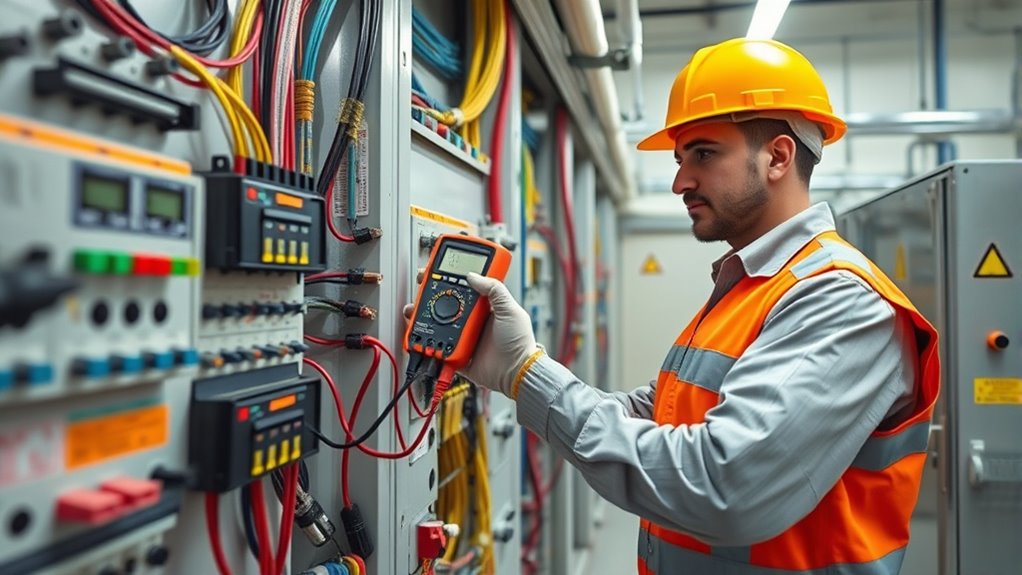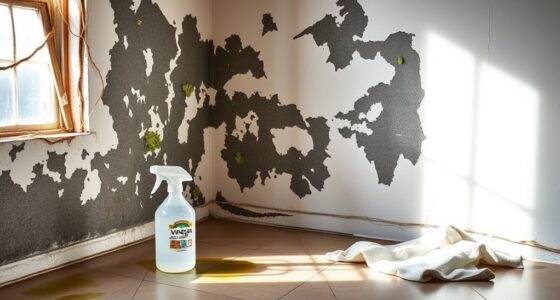After an outage, guarantee your safety first by inspecting the area for hazards like damage, scorch marks, or frayed wires. Check that your main circuit breaker is intact and functioning properly, resetting any tripped breakers with care. Test outlets, switches, and surge protectors to confirm power flows correctly, and verify critical equipment works safely. Keep an ear out for unusual noises and a nose for burning smells. Taking these steps confidently lays a strong foundation—continue to explore each detail for full assurance.
Key Takeaways
- Conduct a thorough safety assessment, checking for visible damage, scorch marks, and environmental hazards before starting electrical checks.
- Inspect and test circuit breakers for proper function, damage, and correct labeling to ensure reliable power restoration.
- Reset and verify outlets, switches, and ground fault protectors, ensuring they operate correctly and are free of damage.
- Confirm the functionality of critical appliances and equipment by inspecting cords, testing power flow, and observing for abnormalities.
- Maintain ongoing monitoring by listening for unusual noises and odors, and perform preventative maintenance to prevent future issues.
Assessing the Safety of the Area
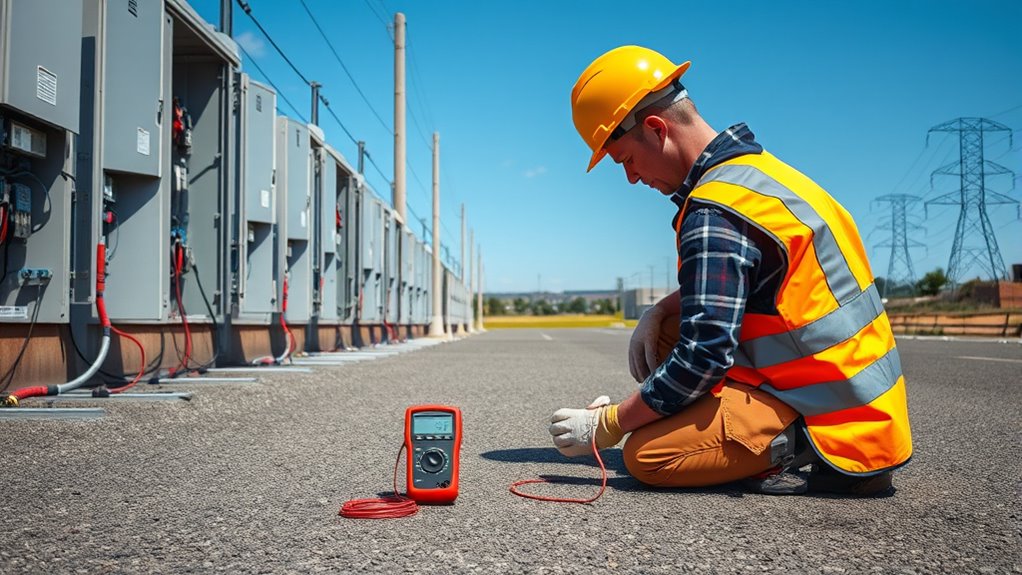
Before starting any electrical checks after a power outage, you need to evaluate whether the area is safe. First, check the humidity levels; high humidity can cause moisture buildup, increasing the risk of short circuits. Ensure the environment is dry and well-ventilated before proceeding. Next, consider the electrical load. Avoid plugging in multiple devices at once, especially if circuits seem overloaded or warm to the touch. Excessive load can cause wiring to overheat or trip breakers unexpectedly. Look for visible damage, such as frayed wires or scorch marks, which could signal underlying hazards. Always prioritize safety—if anything seems suspicious or unsafe, wait for professional inspection. Taking these initial precautions helps prevent accidents and protects both your equipment and yourself. Additionally, understanding sector performance metrics can inform how you plan for future electrical upgrades or maintenance in large facilities.
Inspecting the Main Circuit Breaker
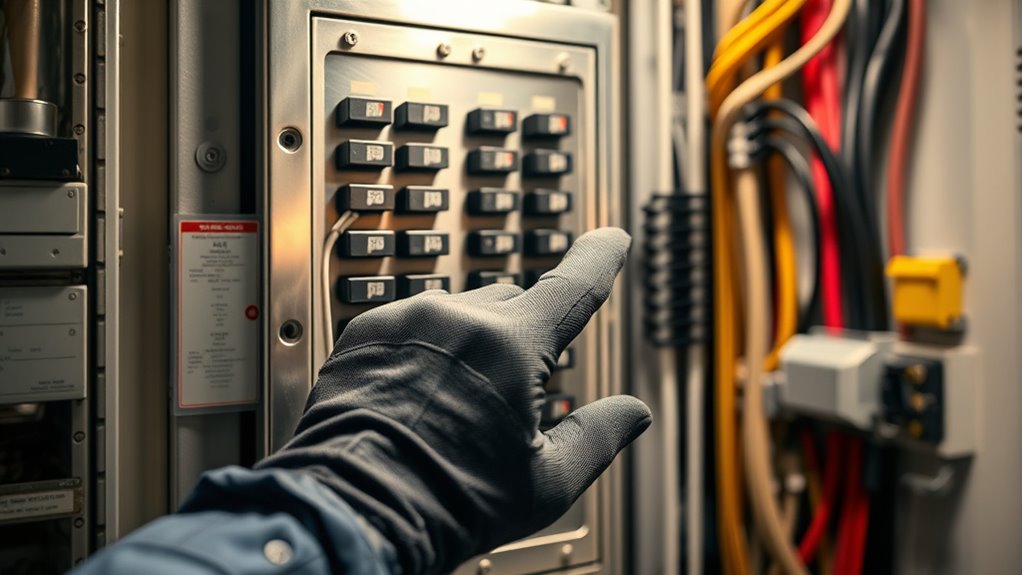
Start by visually inspecting your main circuit breaker for any signs of damage, corrosion, or loose connections. Next, use a testing device to check the circuit’s continuity and make certain it’s functioning properly. These steps help confirm that your breaker is safe and ready for use after an outage.
Visual Inspection Techniques
Inspecting the main circuit breaker visually is a crucial step in guaranteeing your electrical system’s safety and reliability after a power outage. Look for signs of damage, corrosion, or burn marks that could indicate underlying issues. Use color coding to quickly identify breakers associated with specific circuits, making future inspections easier. Proper labeling techniques help you understand the function of each breaker, reducing the risk of accidental switch-offs or misdiagnoses. During your inspection, focus on these key points:
- Check for any discoloration or melting on the breaker
- Confirm that labels are clear and legible
- Ensure color coding matches circuit functions
- Be aware of automation trends that influence modern electrical systems and maintenance practices
Taking these steps ensures you catch potential problems early and maintain a safe, organized electrical system.
Testing Circuit Continuity
Have you verified that your main circuit breaker is functioning properly after a power outage? Testing circuit continuity guarantees your breaker maintains circuit integrity. Use a continuity tester to check if electrical paths are intact. If the tester beeps, it indicates a complete circuit; no beep suggests an open circuit. Here’s a quick reference:
| Step | Action | Result |
|---|---|---|
| Turn off power | Prevent shocks and ensure safety | Power is off |
| Connect tester to breaker | Attach probes to breaker terminals | Proper connection |
| Test circuit | Observe the continuity tester’s response | Beep for continuity, silence for break |
| Confirm circuit integrity | Repeat at different points if needed | Ensures consistent circuit integrity |
This process confirms your main breaker’s circuit integrity and safety. Additionally, verifying electrical safety practices ensures your entire system remains reliable.
Resetting Circuit Breakers Safely

Before resetting a circuit breaker, make sure your hands are dry and you’re standing on a dry surface to prevent electrical shock. First, identify the reason for the trip—overload, short circuit, or fault—then verify it’s safe to reset. Remember, the circuit breaker capacity is designed to protect your wiring; exceeding it can cause damage. When resetting, use the proper method for your breaker type—usually flipping it fully off before back to on. Be aware of breaker trip mechanisms that may delay resetting if a fault persists. Consulting your home security system can provide additional alerts if abnormal activity occurs during such electrical issues.
Checking for Visible Damage or Burn Marks

After an outage, carefully examine your equipment for any discoloration or melting signs. Check for physical damage like cracks, dents, or warped components. Spotting these issues early helps prevent further problems or safety hazards. Additionally, inspect for proper venting to ensure there are no blockages or leaks that could lead to dangerous gas buildup.
Inspect for Discoloration or Melting
Inspecting for discoloration or melting is a crucial step in evaluating the condition of your electrical system after a power outage. Look closely at outlets, switches, and wiring for any discoloration signs, such as darkened or burnt-looking areas. Melting indicators include warped or deformed insulation or components that feel soft or sticky. These visual cues can signal overheating or damage that needs urgent attention. Regularly checking for proper airflow around electrical units can help prevent overheating issues. Notice any faint burning smells or soot residue. If you spot any discoloration signs or melting indicators, avoid using the affected outlets or equipment and consult a professional electrician immediately. Addressing these issues promptly helps prevent potential fire hazards or further damage.
Look for Physical Damage
Have you checked your electrical system for visible damage or burn marks? Look closely at wires, outlets, and switches for any signs of physical damage, such as cracks, scorch marks, or melted insulation. Corrosion signs, like greenish or rust-colored deposits, can indicate moisture intrusion and potential failure points. Clear obstructions around panels and connections help prevent overheating and electrical fires. Physical obstructions, like debris or loose components, can interfere with proper operation. Don’t ignore minor damage; even small burn marks or corrosion signs can signal underlying issues. Visually inspecting your system thoroughly guarantees you catch problems early, reducing risks and preparing your system for safe restart. Always handle visible damage with caution and consider professional help for any suspicious findings. Checking for air quality indicators can also help identify hidden issues that might affect electrical safety.
Testing Outlets and Switches
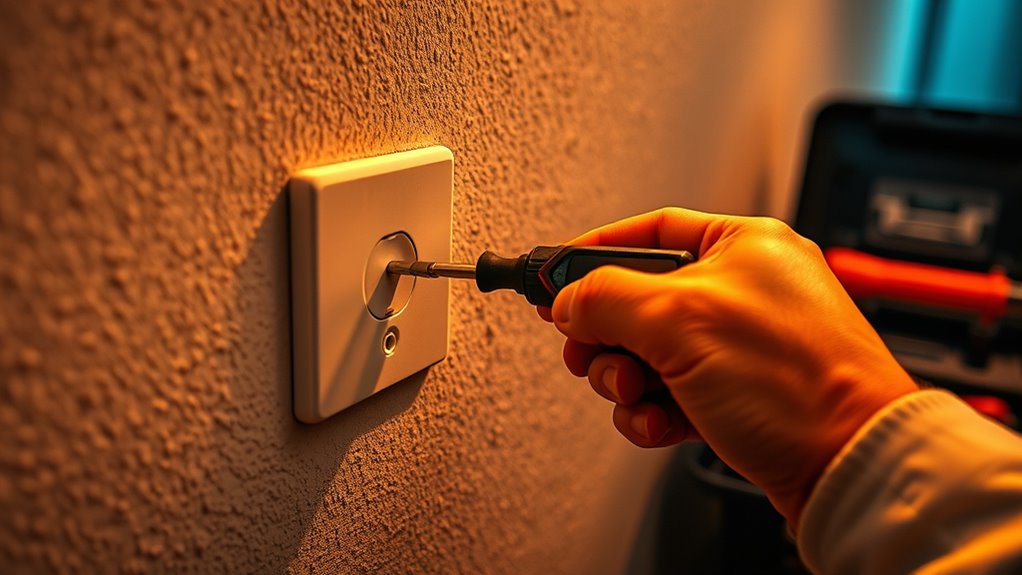
Once the power is restored, you should immediately test your outlets and switches to guarantee they’re functioning correctly. First, check each outlet by inserting a tester or small appliance to confirm power flow. Pay attention to outlet wiring issues that might have occurred during the outage. Next, test switches to ensure they control the intended lights or devices properly, verifying switch compatibility with existing fixtures. You can also verify that your electrical system maintains proper outlet wiring standards to prevent future issues. Use a voltage tester to confirm outlets are live and properly wired. Flip switches multiple times to verify consistent operation. Look for any loose or damaged switch connections that might need fixing. Perform these checks methodically, and if you notice any irregularities, avoid using affected outlets or switches until they’re inspected and repaired.
Verifying the Functionality of Major Appliances

Start by inspecting the power cords and connections to verify they’re secure and undamaged. Then, turn on each major appliance to confirm they operate correctly. Finally, check your circuit breakers to make sure they haven’t tripped and are providing proper power. Additionally, ensure that any critical paint sprayer accessories are properly assembled and functioning to prevent issues during use.
Inspect Power Connections
After restoring power, it’s vital to verify that your major appliances are functioning correctly. Start by checking each appliance’s power cord for damage or loose connections. Make certain the cord is securely plugged into the outlet. Perform outlet testing by plugging in a small device or using a tester to confirm power flow. Look for any signs of burnt smell or sparks when plugging in appliances. Confirm that switches are turned on and cords aren’t pinched or frayed. Here’s what to focus on:
- Inspect power cords for damage or wear
- Test outlets with a tester or small device
- Ensure appliances are plugged in securely
Test Appliance Operation
With power connections confirmed secure and outlets functioning properly, it’s time to verify that your major appliances operate correctly. Turn each on and observe their startup and performance. Listen for unusual sounds, check for error messages, and ensure they run smoothly. This step helps with appliance troubleshooting and confirms power efficiency. To visualize, imagine this table:
| Appliance | Check for Proper Operation | Signs of Issues |
|---|---|---|
| Refrigerator | Runs quietly, maintains temp | Unusual noises, leaks |
| Washer | Drains and spins correctly | Vibrations, leaks |
| Oven | Heats evenly, responds to controls | No heat, error codes |
| Dishwasher | Cleans dishes effectively | Poor cleaning, leaks |
Confirming each appliance’s functionality guarantees safe, efficient operation after an outage. Additionally, inspecting electrical connections can help prevent future issues.
Check Circuit Breakers
Checking your circuit breakers is a crucial step to guarantee your appliances are receiving power properly. First, locate your breaker box and review the circuit breaker labels for each circuit’s purpose. Confirm each breaker is in the “on” position; if any are off or stuck, reset them by flipping off and then back on. Proper breaker box organization makes this process easier, helping you identify circuits quickly.
- Confirm that no breakers have tripped or are loose.
- Check for any signs of damage or burning smells.
- Label any unidentified breakers for future reference.
Keeping your breaker box organized and well-labeled helps prevent confusion during post-outage checks, ensuring your major appliances function safely and efficiently.
Examining Ground Fault and Surge Protectors
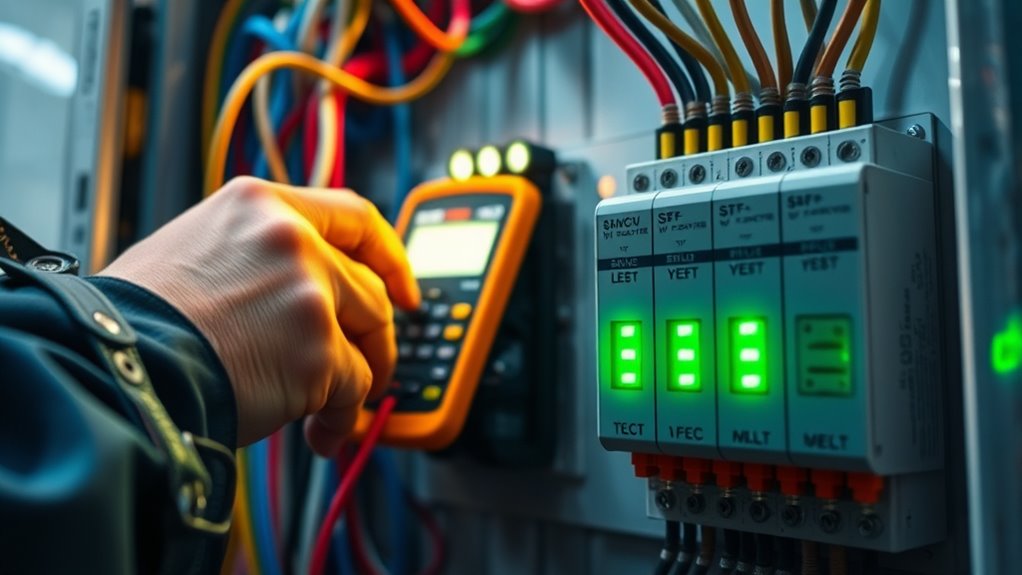
Have you ever wondered if your ground fault and surge protectors are working properly after an outage? It’s vital to check them to ensure your safety and prevent future damage. Start by inspecting your surge protectors for any visible signs of damage, like scorch marks or frayed cords. Test the indicator lights; if a surge protector’s light is off, it might be compromised. For ground fault protectors, press the test button to ensure it trips properly and then reset it. If it doesn’t trip or reset correctly, replace it immediately. Remember, these devices are your first line of defense against electrical surges and faults. Regularly verifying their operation after outages helps keep your electrical system safe and reliable.
Restoring Power to Specific Circuits
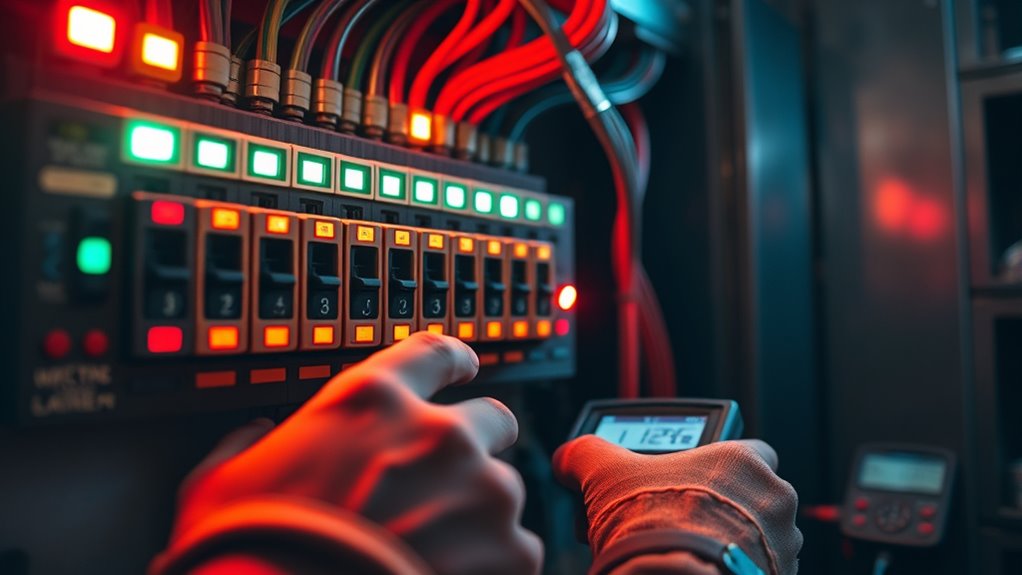
After verifying that your ground fault and surge protectors are functioning correctly, you can begin restoring power to specific circuits. Start by consulting your circuit labeling to identify the correct breaker for each area. Before flipping breakers back on, perform a power surge analysis to ensure there are no lingering electrical issues. When restoring circuits:
- Turn on breakers one at a time to monitor for overloads or sparks
- Check each circuit’s outlets and appliances for proper operation
- Confirm that no unusual smells or signs of overheating appear
This step-by-step approach helps prevent damage and guarantees safe power restoration. Taking your time and paying attention to circuit labeling improves safety and efficiency during this process. Remember, careful restoration minimizes the risk of future electrical problems.
Monitoring for Unusual Noises or Smells

Monitoring for unusual noises or smells is a critical step in ensuring your electrical system’s safety after restoring power. Sound detection helps you identify problems early, such as buzzing, sizzling, or clicking noises that could indicate loose connections or faulty components. Odor recognition is equally important—burning or smoky smells often signal overheating or insulation issues that require immediate attention. As you check, listen carefully for any irregular sounds and sniff for unusual odors near electrical panels, outlets, or appliances. Address any anomalies promptly, turning off power if needed, and consult a professional if you’re unsure. Staying alert to these signs minimizes the risk of fire or damage, keeping your home safe after a power outage.
Planning for Preventative Maintenance
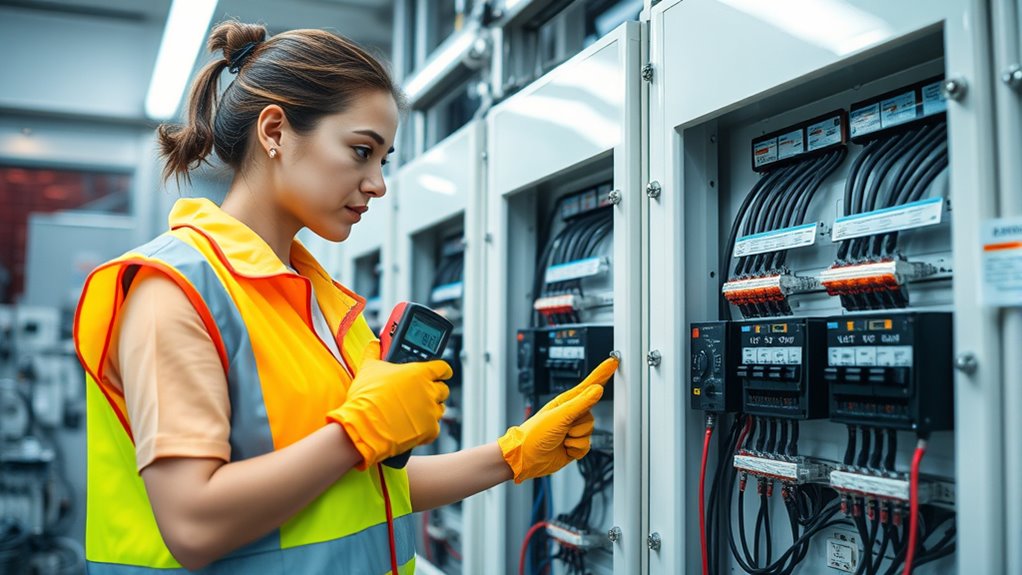
Regularly scheduled preventative maintenance plays a vital role in keeping your electrical system safe and reliable over time. Proper planning guarantees issues are caught early, reducing downtime and preventing costly failures. To effectively prepare, focus on key areas like:
- Performing regular equipment calibration to maintain accuracy and performance
- Conducting staff training so your team understands maintenance procedures and safety protocols
- Establishing a maintenance schedule that aligns with your operational needs and equipment lifecycle
Frequently Asked Questions
How Often Should I Perform Post-Outage Electrical Checks?
You should perform post-outage electrical checks after every power outage to guarantee safety and system integrity. Follow your maintenance schedules closely and consult troubleshooting guides for specific procedures. Regular checks help identify potential issues early, preventing future problems. If outages are frequent, consider more frequent inspections. Staying proactive with these checks keeps your electrical system reliable and safe, reducing downtime and costly repairs down the line.
What Safety Gear Is Recommended During These Checks?
You should wear appropriate personal protective equipment and electrical safety gear during post-outage checks. This includes insulated gloves, safety glasses or goggles, and flame-resistant clothing to safeguard against potential electrical hazards. Make sure your footwear is non-conductive, and use insulated tools whenever possible. Always inspect your safety gear before use to guarantee it’s in good condition, and follow all safety protocols to stay protected throughout the process.
Can I Reset Circuit Breakers if I’m Unsure of the Cause?
You shouldn’t perform a circuit breaker reset if you’re unsure of the cause. Electrical troubleshooting requires identifying the root issue first to prevent potential hazards. Resetting the breaker blindly could hide underlying problems, risking further damage or electric shocks. Always verify you understand the reason for the trip, check for signs of trouble, and if uncertain, consult a qualified electrician. Safety comes first during any electrical troubleshooting process.
How Do I Distinguish Between Normal and Abnormal Electrical Smells?
You can tell normal from abnormal electrical smells by focusing on smoke detection and burning odors. If you notice a faint, chemical scent without smoke, it might be harmless dust or overheating, but a strong burning smell or visible smoke signals danger. Act quickly—turn off power if needed, and investigate. Abnormal smells often indicate wiring issues or electrical faults, so don’t ignore them; safety always comes first.
When Should I Call a Professional Electrician After an Outage?
You should call a professional electrician immediately if you notice persistent electrical smells, unusual sparks, or any signs of electrical damage after an outage. Prioritize home safety and emergency preparedness by avoiding further use of affected outlets or appliances. An electrician can assess and fix potential issues safely, preventing fire hazards or further damage. Never delay professional help when electrical problems threaten your home’s safety or your peace of mind.
Conclusion
Now that you know the basics, you’re like a skilled navigator steering through electrical recovery. By following these steps, you guarantee safety and restore power smoothly, much like restoring calm after a storm. Remember to stay vigilant for any signs of trouble and plan regular maintenance. With confidence and care, you’ll keep your electrical system running safely—like a lighthouse guiding ships safely home.
